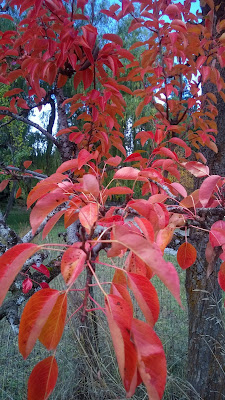 |
| Find Jamie in this photo. |
Autumn is ending, but a walk with the cats still reveals intriguing sights.
The creek takes on color as leaves drift down. I played in this creek as a child in summers when it wasn't so icy.
Claire found a warm spot at the corner of the old log barn where Dad stored hay. Now fallen in, it was built by Mr. Cable in the 1890s.
A few apples cling to branches. Sour and hard in October, this late apple is now crisp and sweet, despite frosty nights. I shake one down to munch while I walk.
The deer will wait near an apple tree for apples to drop. We have over one hundred wild apple trees on the place -- and lots of deer. Bears come through every evening, too.
You never know what you'll run across if you take a different route.
A tramp over our 66 acres is enjoyable, even more so with friends along.










































